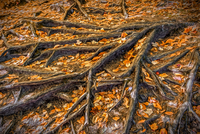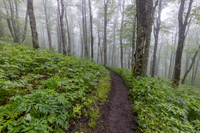Why Does Forest Soil Carbon Matter?
Trees capture carbon from the atmosphere and store it in their wood, leaves and roots, helping mitigate climate change. But trees aren’t the only part of a forest that stores carbon. Their soils are a second, often larger carbon storehouse, but one that is poorly understood.
There is little comprehensive data about how much carbon forest soils store and what management strategies might boost or harm that storage capacity. As the climate crisis intensifies — along with interest in forests as a natural climate solution — it’s essential that we better understand and protect the carbon in forest soils.
Our Forest Soil Carbon Research
American Forests’ Forest Soil Carbon Initiative is a comprehensive, multi-year research project that aims to bring the carbon underground to light. We partner with the Northern Institute of Applied Climate Science — a research branch of the United States Forest Service — to gather and analyze data and to translate these findings for practical, on-the-ground applications.
This first-of-its-kind research will accomplish four goals:
- Develop a research methodology for including soils in forest carbon calculations and management planning
- Shed light on how forest management actions, such as logging or controlled burns, impact soil carbon
- Work up a “menu” of forest management practices that protect and increase forest soil carbon
- Create detailed maps of soil carbon risks and opportunities to guide land managers’ decisions
As part of our research, we determine how soil carbon relates to factors including soil type, forest age, topography and past events such as logging or wildfire. We map areas where soil carbon is particularly vulnerable to being lost and where it could be most effectively restored. And we identify any forestry practices that might help. This research will help forest managers make informed decisions about their forests, understand how their soils may specifically be affected and include soils in forest carbon considerations.





What We’ve Accomplished
American Forests launched this research in 2018, when we partnered with the Maryland Department of Natural Resources to collect and analyze data about the state’s forest soils. This research identified the particular vulnerability of soil carbon on steep slopes and the high risk of carbon loss in shallow soils. We are now applying this research methodology to Oregon, Washington, Minnesota, Michigan, Wisconsin and North Carolina. We are working with staff at natural resource agencies in each state to ensure our research best fits their needs.
As our research has revealed, there is no one-size-fits-all approach to managing forests for carbon. For example, in the Lake States, physical factors, such as a soil’s texture and water retention, play a big role in how much carbon soil contains. In the Pacific Northwest, in contrast, wildfires are one of the biggest influencers of forest carbon, capable of incinerating not only trees but the organic matter stored in soil.
Regardless of the influences on soil carbon capture in a given place, however, sustainable forestry practices — such as controlled burns or leaving a mulch of branches and leaves behind after harvesting — often closely align with tactics to conserve soil carbon.



